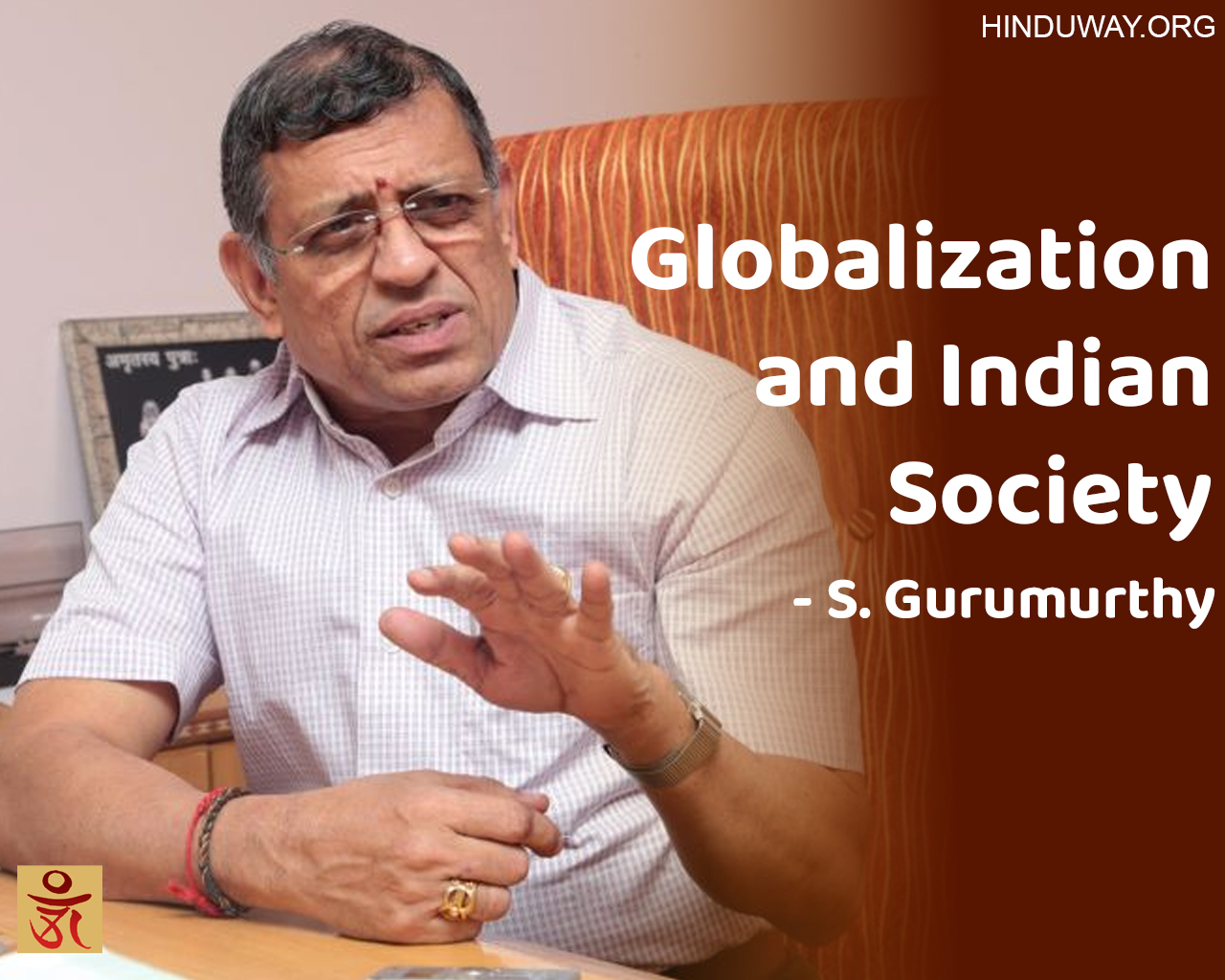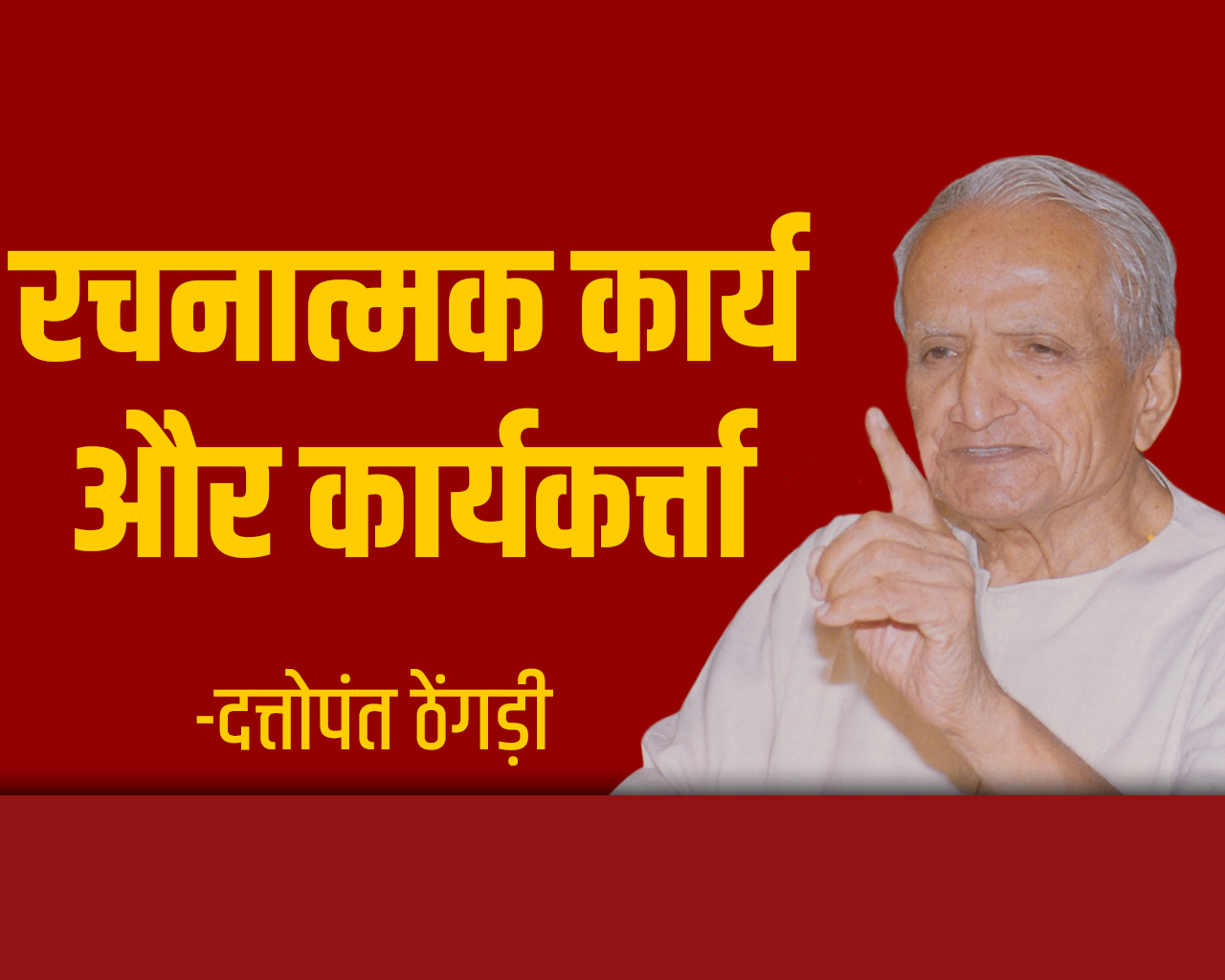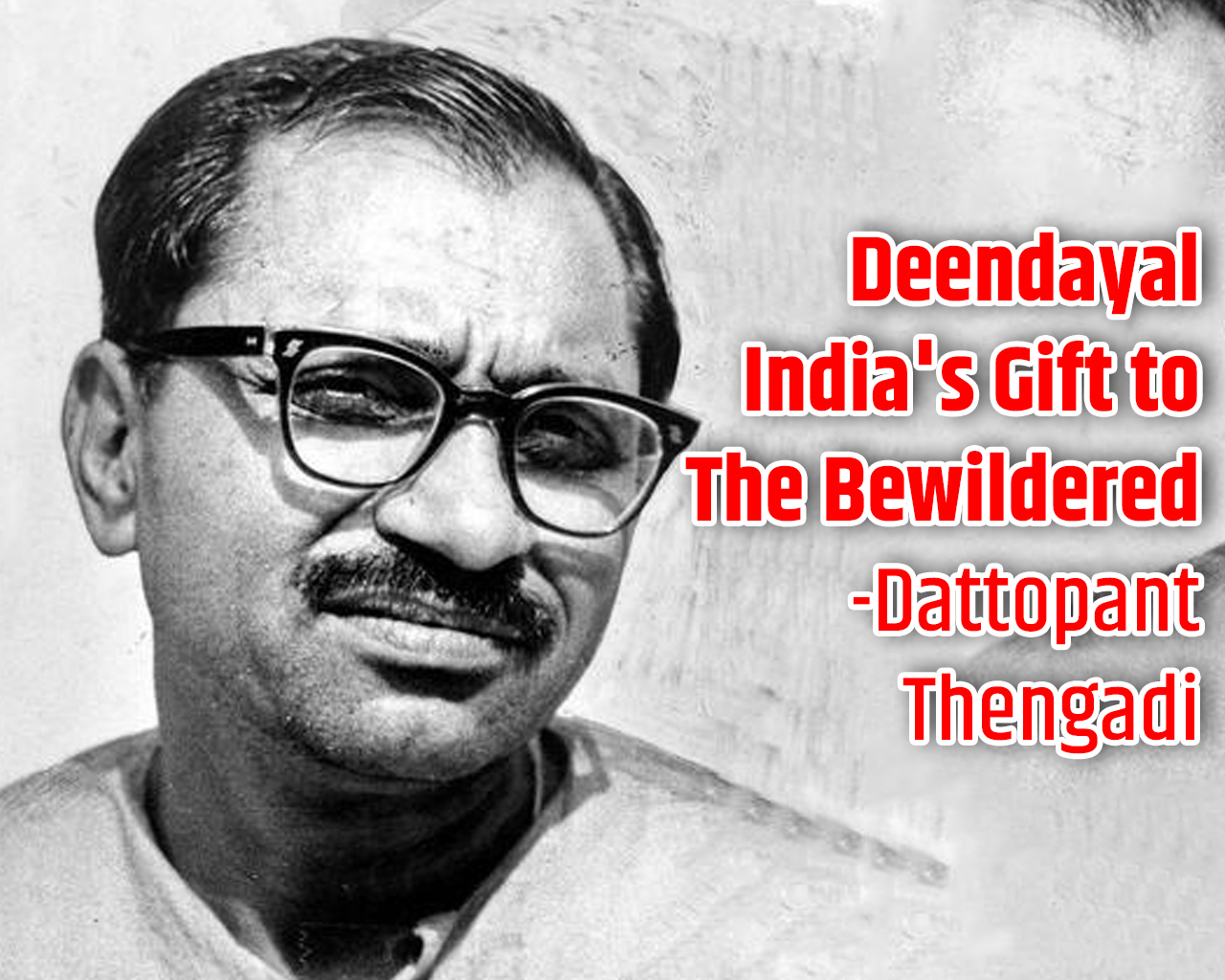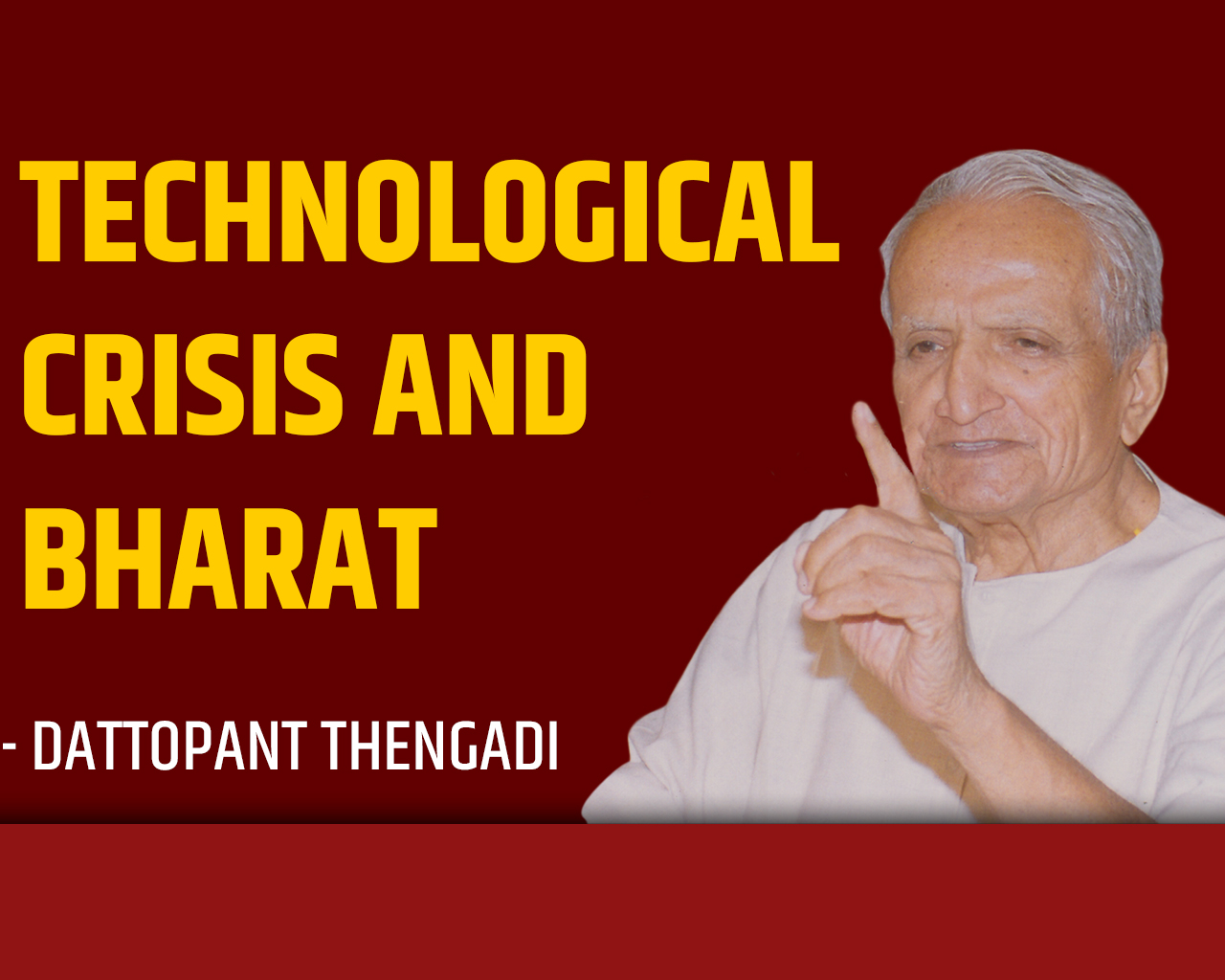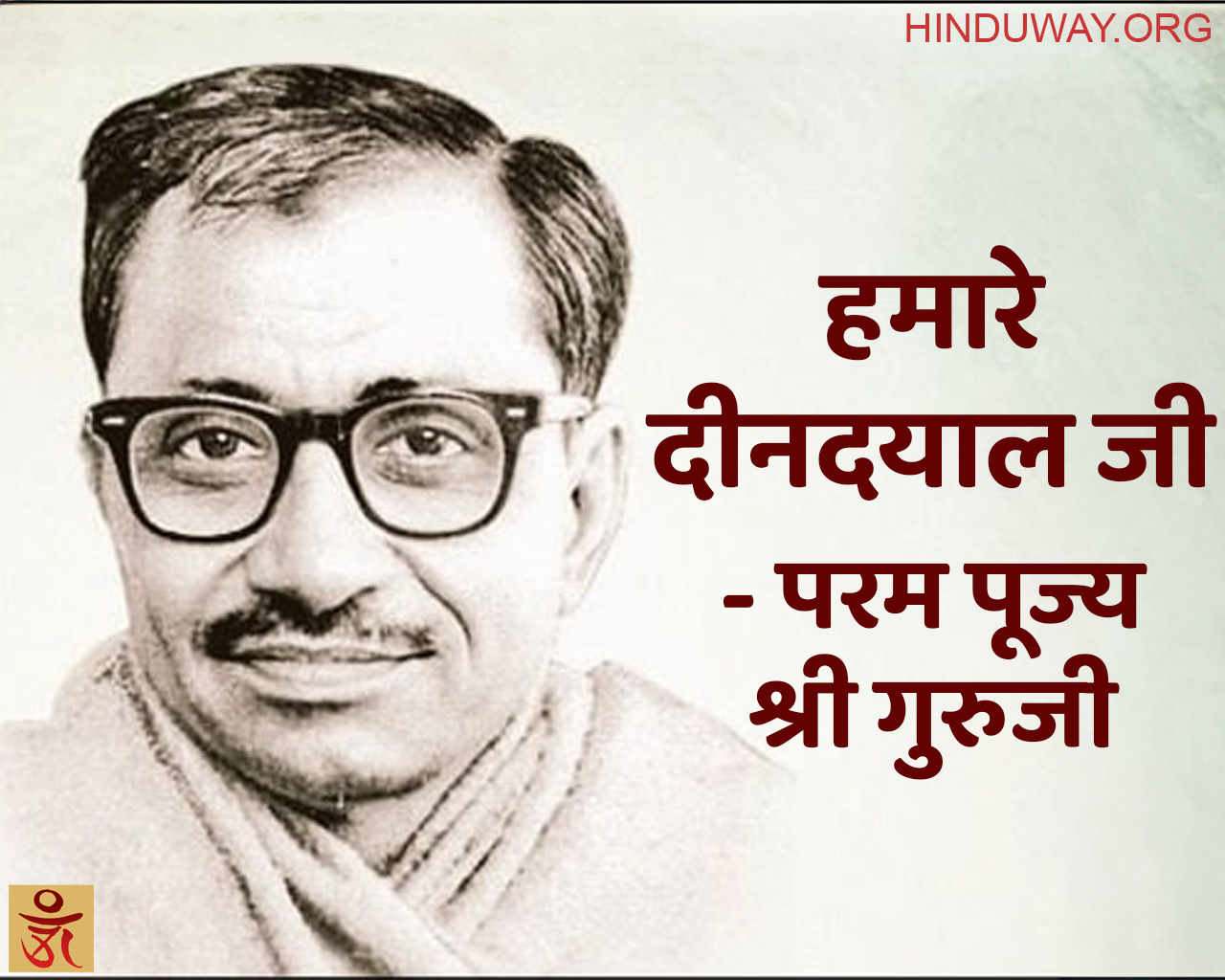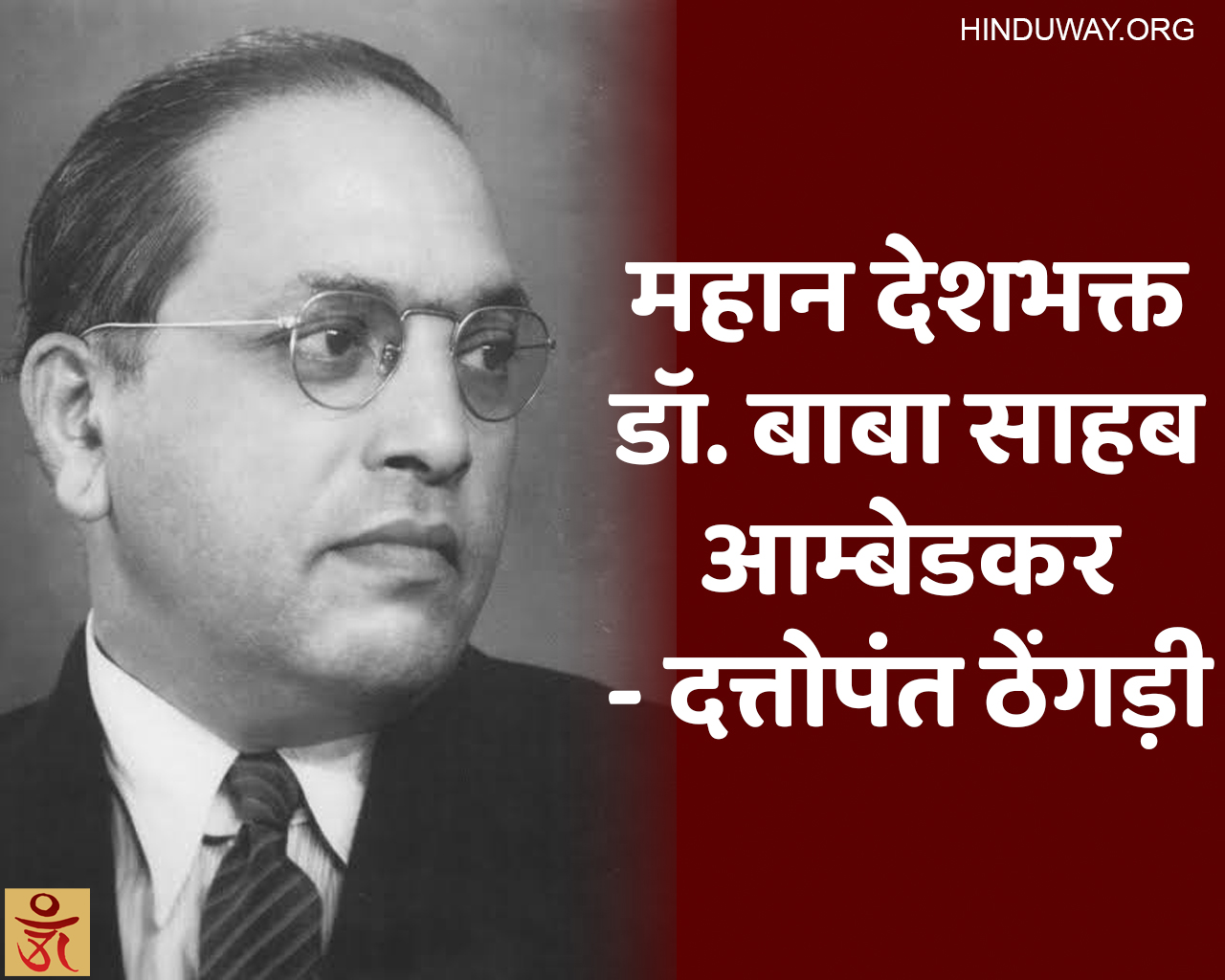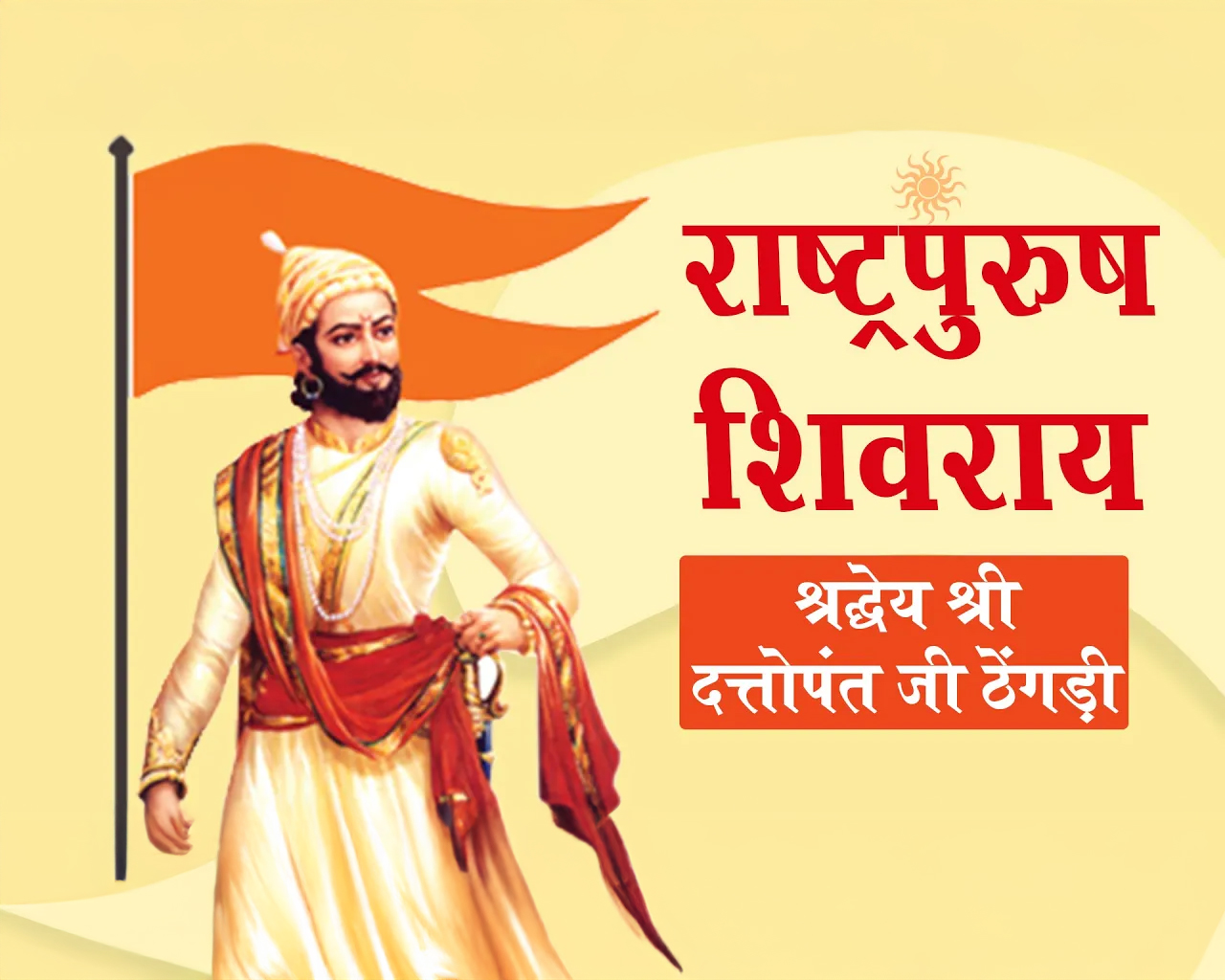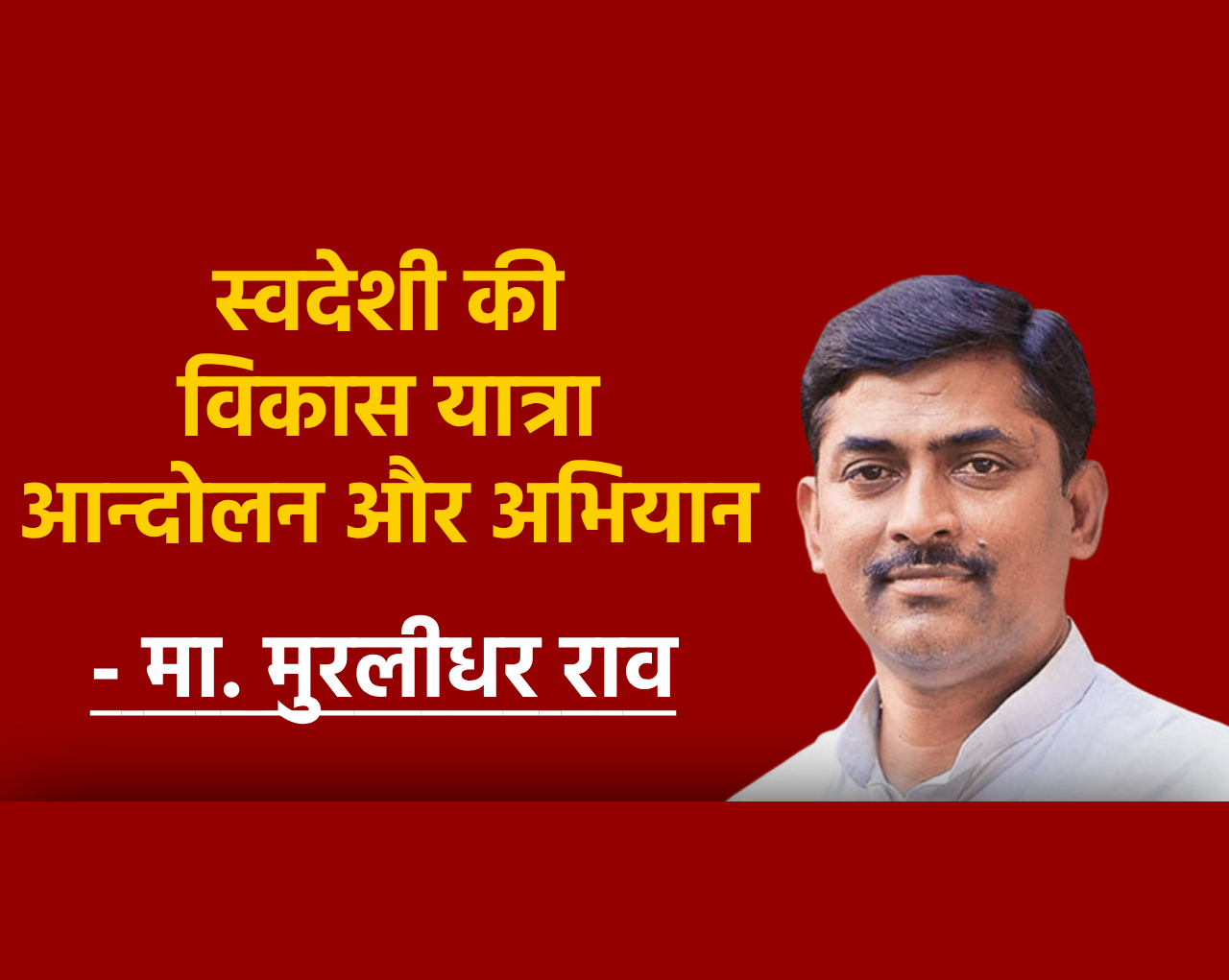Manniya shri Advani Ji, who for the last three decades have been some kind of a pole star for me; which I used to confess to him that after my mother, I always look up to Advani Ji for personal clarity, and is one of the pole stars of honesty and probity left in this country. I am very happy that after 18 years, I have been called to address a BJP meeting. Last time, Advani Ji called me to address large number of karyakartas and thinkers of BJP in Jhinjoli in 1994, and after that this is an opportunity which I have to share my thoughts. And, my friend Balbir Ji and dear brothers and sisters who have assembled here, the topic is “Globalization and Indian society”. Obviously Balbir knows where the drift of my study has been in the last three decades. That’s why he has chosen the world ‘Indian Society’ rather than India.
I am extremely happy that I have been called to address the first meeting of the Vivekananda Study Circle. My association with Swami Vivekananda has been the gateway to understanding India. I was in a village, educated in Tamil medium, and when I came to Madras city and joined the Vivekananda College, I could not understand one sentence of english; and the Vivekananda college monks took so much pity on me, coached me, in three months they transformed me into not only a student who could understand English, and a bright student. And afterwards I passed out in CA Examination with all India colors. That only gave me the academic distinction but far more from that was Swami Vivekananda’s total influence on my thinking, and that’s what later led me to join the RSS and I can understand this country better when I can see this country, this society, our whole public life through the vision provided by Swami Vivekananda. It has also largely influenced my thinking which I will be presenting here.
See, for a political party which is context bound, to take up a topic of this kind which is a large text, is a combination which we rarely see, every political party is interested in dealing with the day to day situation. But Globalization, as an economic, as a politico-economic phenomena; what impact it will have on the Indian society, is a very large issue, which transcends all context, you cannot limit it to a context. In fact, it may not be fitted into a context. So I am happy that the BJP is taking up an issue which is not unrelated to the context, but which transcends the context. But it is very important because if a party where to lookup on what its responsibility is in handling this society, the nation, the polity and the institutions associated with it, the core understanding will have to be of what this society is, and if you look at Globalization, which is about two decades old, and this came like a tsunami in the early 1990s, and everyone’s mantra was globalization. And today if there is any word which is practically absent in the global discourse, it is Globalization. I don’t think anyone very seriously talks about Globalization today, people talk about Global trade, Global investment, about Global demand and Global supply etc. But there is no discourse about globalization today because the world has got fatigued with the idea of globalization, because it was an undefined concept, ill-defined concept and poorly executed. It has produced enormously wrong results not only for people who are not part of the decision making about Globalization, but also people who decided about globalization.
And 2008 has proved that the basis on which globalization was driven, the theories – the financial theories, the market theories, the theories about the relationship between the people and the society, the government and the people, have all proved to be wrong in June 2010. The Economist Magazine came out with the cover story on the state of the economic theories today. It said, “The economic theories expounded in the last 30 years, which incidentally produced globalization are useless at best, and positively harmful at worst.” All the theories for which noble prizes were given, were found to be not only faulty, but they were also found to be harmful like what is known as Black–Scholes model, about which I will make a mention in the course of representation. When the Tsunami of globalization struck India and we had no intellectual wherewithal or basic groundwork to understand what its impact is going to be on us. There was no Literature; there was no counter opinion building. It was a complete mass defection from the socialist pursuit to the market pursuit, and some of us who did not agree with it did not know how to stop and make the people think that this may not be the right way. So we started travelling across countries, and all that I am going to share with you today, is the empirical knowledge which all of us gathered as to what happens in Ludhiana, Batala, Rajkot, Jamnagar, Morbi. Right down to tuthukudi, we visited about 42 Industrial clusters in a period of about 5-6 years and found that the assumptions on which policies are being decided. The economic discourse that is taking place in this country has nothing to do with the productive energy of India and I will give you a small example. All of us are very educated, we think about the country, we are concerned about the country. But how many of us know which is the place which has the highest per capita income in India? It is not Bombay. It is not Delhi. It is not Kolkata. It is not Chennai. It is not Bangalore. It is not Hyderabad. It is a small place called Morbi in Gujarat, where people made the Ajanta wall clock; and it is a small community, and you go, you can’t talk to anybody in english, because no body would understand English. When I was talking to the Rajkot Industry’s association Chairman, we talked till about 2 o’clock in the morning from about 9 o’clock in the evening. The only common word in English which we could understand was the word Baroda. He knew nothing about English, but they have setup such a powerful Industrialist Establishment. And it opened my eyes. It is not done by Universities, they produced universities. It is not engineering colleges that set up these kinds of models, but they setup Engineering Colleges. Take Coimbatore for instance, it is the Industry which setup educational institutions and not vice-versa. So, this gave me a totally different perspective that what is happening in this country is not reflected in the economic discourse of India, and it is with this perspective I am going to share with you what is my understanding of the Indian society, and what we, the intellectuals of India, the academics of India, the educational institutions of India, and I would partly put the blame on the political class of India who have not traced the economic history of India. I will share my experience in the IIT, Bombay, where in 2010, they had invited me to share platform with Mr. Adi Godrej and he was to speak first and I was to speak later, and it was a very-very tough program where research scholars, students, academics, all were there. And, he spoke brilliantly for an hour in which the quintessence of his thought was that India has been a great civilization. It knew philosophy, it knew spirituality, it knew how to co-exist with differing thoughts, but the one area where it has been a thorough failure was economics and we started putting Economic performance only after Globalization came in, otherwise we had only what is known as the ‘Hindu rate of growth.’ You know the entire audience clapped, and he was given a roaring reception. And, I had gone with a particular mindset to speak, and I had gone with certain points, and I kept aside all points and I was surprised that in such an institution of such high learning which is going to brand India, which is going to represent India as a rising intellectual giant, IITs and IIMs. I was surprised by the kind of ignorance about India so I decided to keep aside the notes which I had taken and begin talking on what is the current western understanding about the Indian economic performance.
You know, our mind about India was made by scholars who never visited India, who never dealt with Indians, who never read any Indian literature. Take two persons, for instance, Karl Marx – in the year 1853, before he wrote the Das capital in 1857, Karl Marx wrote couple of articles, actually on 25th June 1853. In the New York Herald Tribune, he wrote two articles in which traced what his understanding about India was. He said it’s a very peculiar country. It’s one country no doubt, and it has some kind of a centralized living model, and it’s infrastructure, and mobility of the people are looked after by Kings who somehow function together. But economically if you look at the country, every village is an economic unit, a tariff unit, and it doesn’t import or export anything. It produces and consumes. The producer is also the consumer; the consumer is also the producer, which he later on called the ‘Asiatic method of production. ’ He said it’s a very peculiar country and there is no economic inequality because no one has any power over others. This was called the primitive socialism in the communist terminology even today. But he said there is something very wrong with this society, they are worshipping monkeys, and they are worshipping cows. And, such a backward society can never progress and carry out a revolution which is necessary for advancement of the human race. It is necessary to destroy the social base, the society and that work the British is doing. Even though it is a painful destruction, it is a pleasurable destruction also. This is what Karl Marx said. You know he never came to India, he never read any Indian literature, he never met any Indian and spoken about India, but he wrote about India. And you know he became one of the most powerful thinkers influencing the Indian intellectual establishment, political establishment, sociology and economic thinking. And our academics are still under the grip of these powerful thoughts, that India is ‘semi-barbaric’, this is what he [Karl Marx] classified India as. And then another person, Max Weber, less known, but a more powerful social thinker. He was the man who aligned economics and, and wrote a book called sociology of Economics, which defined why the protestant societies are coming up and Catholic societies are lagging behind, and he said that a protestant society, because they release a person from the control of the church and from the control of the hierarchy, it reopens a person to individualism, entrepreneurship, enterprise, and so they are more fitted to handle capitalism, and he predicted that in early 1900, America would become an economic power only because of the protestant ethic, he was absolutely right as per the Christendom. The relative values of capitalism with protestant Christianity and catholic Christianity. And he is one of the most powerful and influential thinkers of the sociological and economic establishments and academics all over the world today and there are researches which show that these two thinkers influenced India, Indian establishments more than any other intellectual. And I would have been very happy if Max Weber had stopped writing with only his understanding about Europe and America. But he wrote a book in 1925 which was not published till 1950. That was about the religion of Hinduism and Buddhism, in which he said two societies can never come up; that is China and India, because they believe in Karma and rebirth, which is anti-enterprise, anti- entrepreneurial development, and so these two nations can never come up. You know researches after researches have confirmed that Indian political, sociological, economic and political establishments have been powerfully influenced by these two thinkers. And afterwards, you know, came here, John Kenneth “Ken” Galbraith came here, a great friend of Pundit Nehru, and he said I can’t understand, Indian is a ‘functioning anarchy’. That it is an anarchic society, but surprisingly it is functioning also, and we quoted all this. We defined ourselves through Karl Marx, through Max Weber, through Galbraith, and then came Professor Raj Krishna. He was asked “why India is growing so slowly?” He said it is the Hindu rate of growth. This was 1978. That’s how we defined India. India was defined by people who had nothing to do with India, nothing to do with understanding Indian the society and Indian civilization and you know your remarkable u-turn took place in the world about which no one has cared to understand, that in 1970s, when Japan began rising as an economic power, the west was surprised, because Economic development, economic progress is supposed to be the preserve of the west. How could Japan, from Asia, an underdeveloped place, a place which is condemned not to develop. A Buddhist country, how could it develop?
And so, one Paul Bairoch, a Belgian economist, made a thorough study of the economic development of different nations from 1750 to 1918, and he came out with a surprising finding that if in 1750 if you draw an economic statistics of the world, it would look like this, China, 32.8% share in the global GDP, China was the top country in 1750 with nearly 33% of world’s GDP; India was second, which 24.5% of world’s GDP. UK, one of last with 1.8% of world’s GDP. America with 0.1% of world’s GDP. He said that these are the structures of the world economy in 1750s. And India went down 24.5% of the world’s GDP to 20 in 1800, 17 in 1830, 8 in 1880, 1.7 in 1900. In just 150 years, the Indian economy, the Indian polity, the Indian society, Indian civilization crashed. And the same thing happened to China. From 33% in 1750, China became 6% in 1900. And in the same period, UK and USA, which had just about 2% between them in 1750, there share went up to 41% in 1900. This completely transformed, paradigm shifted; transferred the power, economic power, political power, cultural power, civilizational power from Asia to the west. When Paul Bairoch came up with this theory, the west was stunned. It is very likely, that in the middle of the 19th century, the average of standard of living in Europe was a bit lower than the standard of living in the rest of the world. This shook the west. The west was always superior. How is it that the western researches have shown that Asia was a mighty economic giant, and India was an economic giant. And so this job was given, even London economists noted it in the 1990. Then Angus Maddison, the greatest economic historian ever, he was given the responsibility by OCD countries to test and verify whether Paul biro’s research was correct or not. It was not a single man’s research. The instituted what is known as the development studies institute,all the 20 countries funded it and he was given a fleet of research scholars to work with and Angus medicine started his work like this – ‘If Bairoch is right, then much of the backwardness of the third world, that is Asia, presumably has to be explained by colonial exploitation and much less of Europe’s advantage can be due to scientific precocity, continued slow accumulation of wealth and organizational, financial superiority. You cannot say it happened, our growth happened because of this, it has to be with colonial exploitation. This is how Angus medicine started the work and said that Paul Bairoch cannot be correct and Angus Maddison came out with the final conclusion in the year 2001, and till June 2010, Angus medicine kept on publishing his researches in which he said he drew a 2000 year economic history of the world starting from the first year of the common era called AD. He said if you look at the economic statistics in the year 1 of the Common Era, India tops the world with 34% of world’s GDP, China next. In the year 1000, if you draw the economic statistics, India leads with 28%. In the year 1400, India again leads, in the year 1500, India again leads, in the year 1600, China overtakes India, in the year 1700, India overtakes China and Angus medicine came to the conclusion that Indian economic crash occurred essentially and wholly because of colonial exploitation. When I mentioned this to IIT students, scholars, researchers, academics, they were stunned. No one knew. And Adi godrej was also there, it’s all available on YouTube, you can see both the lectures there. And after I completed the lecture, and of course I said more which I will say here. And all of them came and surrounded, sir you don’t stop with giving this lecture. We want you to run a course for us. And I ran a course for them in the first quarter of this year. I took 21 hour course for the entire MBA students in which many research scholars, academics also participated. Why I’m mentioning this is that the tallest educational institution of India, had no understanding of Indian economic history, which is no prove. Actually if you want to look at the Angus Maddison’s work, it is known as, ‘World Economic history- A millennial perspective’, it is available on the internet, OECD even today. You know what is OECD countries? It is the 26 richest countries in the world and their statistics are most trusted and relied upon. It is that OECD forum which has declared this as the most authentic economic history of the world. The benefit of this study, Karl Marx did not have. The benefit of this study, Max Weber did not have. The benefit of this study, Galbraith did not have. Nor Professor Rajkrishna. But still, day before yesterday, I saw articles being written about the Hindu rate of growth. You can understand the diversion between the truth and the myth. The myth about India which has settled in our mind has made us de-brand India, de-value India, de-value the Indian society and all the problems of India we attribute to the Indian society. Take for instance, just the gender phenomena that Indians kill their girl children, all of us accept it. But from 1901, statistics is available. In 1901, the gender ratio of India was 972/1000. It was the highest in the world at that time, in 1901. The world average is even today 960. 972/1000 was the first Indian census calculation of gender ratio. In 1951, it became 946. In 1991, it became 927. In 2011, it has become 940. Now you look up to what is the gender ratio in villages and towns. In rural areas, the gender ratio is 947, in urban areas, 926. Is traditional India caring for women or modern India caring for women? And if you look at the metropolitan area, it is still less. But we blame traditional India, traditional Indian society, and traditional Indian belief systems. This statistics stare at our face, but in the public discourse nobody asked this question – how do you blame traditional India for gender in this country deterioration
It is traditional India which is still preserving it actually. And, I can go on repeating as to how the Indian society has been holding on, but I don’t want to travel more into it except as a side. In 1994, in 1990s when we started to say that Globalization is not going to be the answer for Indian economic problems. That India has its own social moorings, it has its philosophy, and it has its sociology. And after all there is a link between sociology and philosophy. There is a link between philosophy and the way people live, lifestyle, and lifestyle is related to habits, habits are related to what a person needs or doesn’t need. And so there is an integral relationship between philosophy and actual life. And this is not integrated into the study of economics in the west, and so globalization is not going to deliver what it is promising to deliver and what it is being canvassed as being capable of delivering.
And the word society is absent in the western discourse. Margaret Thatcher said in 1971, there is nothing called a society. And all that the west has accepted today is civil society. You know civil society and our understanding of society are totally different. Civil society is a club. Our society is a tradition. And our society is an open air university. It is our society which has produced Ramgarhia community. which has built Ludhiana, Batala, jalandhar. You must go to those places and see. How a community of artisans has built India into the largest spare parts supplier for the cycle industry all over the world. It was not done by any Engineering College. Take Surat for instance, where 15 years ago, people used to come and dirty the city. From the nearby villages, lakhs of people used to come, there was no water, they used to come with their cattle and the whole area would turn into a lavatory. It became a long order problem; the government could not control it because the people would have no way survived in their village. But when they came, in 15 years, they learned diamond cutting. Today Saurashtra is the largest diamond cutting factory of the world. 9 out of 10 diamonds cut in the world are cut in Saurashtra. And because of that, we not only took up Diamond manufacturing, but two-thirds of the global diamond trade which was in the hands of Jews. Out of 25 billion$ diamond trade, 16 billion$ is in the hands of the Gujaratis today. No university accomplished it, no government planning did it. It is the social relationship between the people. You can never create that relationship, you can destroy that relationship. You know in a society which is integrally related by relationship is the ‘society.’ Civil society is a society by contract. There is a huge difference between a relation based society and a society based on contract. A civil society is the product of what is known as ‘social contract theory’, which is the basis on which all constitutions are founded including our constitution in which everyone is related to each other as co-citizens of a country and no other relationship is recognized. That is why in Philadelphia in America, a son could go in the court and file a writ and say that he must be divorce from his father as there is no relation between a father and a son except as co-citizens and the court granted it.
You can understand, that in the total western sense of understanding of an individual, which is known as ‘methodological individualism’ on which the sociology of the west, on which the economics of the west, on which the constitutional theories of the west are founded does not recognize normal human relationship; and our society functions entirely on human relationships. In fact, contract makes a small interlude only in the corporate sector. And that too backed by very powerful relationships is contract. Contract is not what drives India, relationship is what drives India. And I will give you a couple of examples as to what, how it works.
You know in 1992, Mr. Manmohan Singh was the finance minister at that time. He invited Dr. Jagdish bhagwati, who was the person who framed the entire WTO Dunkel treaty, and he was also called the god of free trade. And Jagdish Bhagwati was also regarded as the guru of Paul Krugman, who said only because of my guru, I have got the noble prize now, in the year 2008. Jagdish Bhagwati was himself not a noble laureate, but he was a great economist and he came to India, Dr. Manmohan singh asked him that we are in a mess, how to come up? Please tell us of some way. He said that the problem with India is that they are saving more than what they need. You are saving 23% of your GDP, and your families are saving 19%. Somehow you bring down the savings of families from 19% to 10%, and 9% of savings when it becomes consumption, when people buy more goods, there’ll be more production, there be more employment, and he built a whole theory based on that.
He said unless you destroy family savings, and bring it down to half, there is no way you can develop and for which he said that the biggest problem of India are the Indian women who are very miserly and you must teach them how to spend. For this he said you must build huge malls, bring attractive goods from outside and see that they are moved out of their reservations and that they become consumers instead of being reserved family women. It is a serious advice given by him, it’s a 72 page advice which used to be in the website of the finance ministry till about 2 years ago, I don’t know why they removed it. The government began doing it, but fortunately, this consumerist economics, which was the thrust of the economic reforms at that time, the media was happy, it was getting huge advertisements and the advertising agencies were happy. The choreographers were happy. Songs were there about how to buy the goods and all that, and our women sang the songs, never bought the goods. I will tell you what the consequence of it. You know our savings to GDP ratio in 1991 was 23%, it became 37% in the year 2009. It is now sustained at 34%. You know this is what transformed India.
It is not FDI. The total FDI that has come in the last 20 years, 1991 to 2009, is just 1.8%. That is the savings-investment gaps in this country. So Shankaracharya, who was the economic adviser to the government of India in the year 2011, he wrote an article in business standard that we don’t need money from abroad, for our development. And we were told in the year, you know, in 1994, it used to be told that we need 400 billion$ for infrastructure development. No infrastructure development in India can take place without foreign investment. And we need foreign investment, and foreign investment became the drive for the economic reforms; and we equated economic reforms with foreign investment.
A research work done by Goldman Sachs, global economic paper no. 187. Goldman Sachs says, it is not that India needs only 400 billion$ for infrastructure. Somebody said India requires 620 billion$. He said that’s also not correct. India requires 1.7 trillion$ for infrastructure development in the next 10 years. This paper is 2010, October, global economic paper no. 187 of Goldman Sachs which is available on the internet. It says infrastructure development of 1.7 trillion in the next year, considerably higher than the previous estimates. And you know what they say, for this India will not need even one dollar from outside. I am going to read two paragraphs from the report.
The main channels of funding for infrastructure currently is household savings intermediated through the financial sector to the government which is what spent on infra. And excessive reliance, you see what other countries have done. And what India has not done. And, that is what has made the difference between boom and burst. An excessive reliance on government spending and external financing can lead to boom and burst. The experience of other countries, funding infrastructure needs suggest that the sustainable model leads to healthy balance sheet under reliance or domestic savings channeled through long-term funds such as insurance and pension funds. And it says, what will be the character of Indian savings for the next 20 years. It says, bank deposits will be 48%, insurance 14%, pension/ p.f. 14%, government dues 11%, and shares just 6%. 55% of the American economy is hooked to the stock market. Only 6% of Indian savings will get into stock market. But we value Indian stock markets like Americans value Dow Jones.
See what an amount of economic distortion in our thinking, in our understanding about India. And unless the Indian society has this propensity to save, this propensity to save is about the responsibility of people about the family, about the society, about their standing, about the values which they inherit. All this constitutes the propensity to save. This propensity to save was destroyed in the west. The families got destroyed.
Today 51% of the American families are single parent families, 41% of the children born are born for unwed mothers. 20% of them are born for school-going children. 51% of the American families are dependent on the government support. It has become a govt. dependent society. What was a family dependent society has become a govt. dependent society. The father looks to the govt. for taking care of him not to the son. The unemployed son looks to the govt. for taking care of him and not to the father.
So they destroyed the relationship and built a contract based, rule based, constitutional society which has resulted in what is known as the time-bomb ticking under the American economy. The unfunded Social obligations, social security obligations of America is 104 trillion$ and whereas their GDP is only 16 trillion$. This is the biggest and the most powerful dynamite under the American economy. But in India, this entire thing is looked after by the society, by the family, based on a cultural inheritance. In fact I don’t know whether Advani Ji remembers or not, in the year 2002, one Kumar Bhattacharya had come to Advani Ji’s house and we were discussing, Kumar told me guru you are opposing privatization, you should not be opposing privatization. I said I don’t oppose all privatization of course, Himachal Pradesh’s govt runs autos and taxis, they should be privatized, but there is no necessity to privatize railways in this country. Railways in India transport the whole of Australia in one day. You can’t privatize it.
So when we were discussing I asked Kumar Bhattacharya a question, which is the biggest public burden on the govt. in the west? He said social security. I asked him can it ever be privatized in the west. When Mr. Clinton became the president of America, he appointed Hillary Clinton as a committee to go into privatization of social security in 1990, particularly health security. They came to the conclusion – we have to privatize it. They also came to the conclusion you cannot privatize it because to privatize social security, you need families, you cannot create families by law. By Government order you cannot create families, it is not my saying, it is what Francis Fukoyama said. You can build an army, you can build a bank, you can cadre of employees, but you cannot build families, they are built by culture. But the govt. can destroy families by its law. That’s what they have done. And so, privatization of social security is an impossibility in the west. So I asked Kumar don’t you think social security is privatized in this country? He said Guru, this one point is articulated by Indian economists, Indian policy makers, Indian media, Indian leaders in any part of the world, the balance sheet of GOI India will be more bankable than any other country in the world. That is the power of the society. The Society takes this burden. It’s not only in India, in Japan. You know in Japan one of the things that the US Economists used to talk about Japan is that your financial system is the worst because you are bank based. We are market based, that is stock market based and till 2008, Japan was keeping quiet. In the year 2009 they gave the answer, the bank of Japan carried one lined reply in their website – ‘The world financial systems are at distress, Japan is safe.’ You know what was the answer? I am going to read out to you a very important… this what, paper no. 149, may 2009, bank of international settlement website, the Japanese, the bank of Japan officials wrote –
“Why do Japanese prefer bank deposits over risky financial assets when all financial instruments are well developed and traded in Japan unlike other Asian markets. The most complicated financial instruments are traded in Japan not by the Japanese. The Japanese go to the savings bank account. Only 9% of the Japanese savings go to stock market, you know why? Family. In Germany only 7% of the families are investing in the stock market. In India only 3% of the savings get into stock market. It means what? That wherever there is family orientation, wherever there is relationship, the society takes care of much of what the govt is called upon to do in the west, the anglo-saxon west. But today we are thinking of bringing foreign investment in pension fund.
We must study Germany, we must study France, Italy, Spain, Japan. In none of these countries they allow equity in pension. It is all in bank. German runs one of the most successful bank run pension systems in the world. But we are looking only to America, and there the pension funds have been invested in stock market, and when the stock market comes down the pension values come down. ‘The Standard and Poor 500 companies’ today have a 512 billion$ hole in their pension account because of the stock market fall. But nobody studies here.
It is because you don’t understand the Indian society. Our savings habit is related to our culture, our way of life, our obligations which is formed by relationships. The husband and wife relationships have been transformed into contracts, the maintenance of children have become subjects of contract. But how do you bring in imports that kinds of economics in India? Some mighty issue. So I am triggering all of you to think, because there’s a 30 years study of comparative culture based economics which I am trying to share with you in 45 minutes. It’s not such an easy task. But one thing I want to, I want to trigger all of you to think is that the economic model which we are following is not global economic model because the globe has other models also.
But we are so skewed . Our education, our training, our English training, our love for the western countries, particularly America, and the deep influence the American funding agencies have over our think tanks, our media, that makes us look at only one area, and that is proving to be a disastrous failure today. The American model is failing in America. The state and municipal pension funds have a 4 trillion$ deficit. Their health insurance is supposed to go bankrupt in 2019. Their social security, retirement benefit is supposed to go bankrupt in 2033. They are hoping for a miracle.
We are looking at that system. We are not looking at Germany which is the only country having budget surplus year after year. No other govt. is having in the world. We are not looking at them, we not studying them. So my feeling is there is a fraternal society based, family based, economies in the world, with which we share commonality. And our idea should be to have a wider understanding of the world with whom we relate culturally, socially, infilial models and our economic models will be aligned to them. This enormous amount of work has to be undertaken by a mighty organization.
It has to be undertaken by someone who can acquire power, who can change the thinking of the people by the exercise of that power. And that responsibility according to me is on the Bharatiya Janata Party. And my appeal is, that there has to be a constantly functioning think tank, it need not have to meet. It can be an electronic network where people put in their thoughts but the only thing is people must read. Unfortunately, reading habit has gone down so tremendously in the last one decade also. People don’t even read 10 pages if you give to another person. And the single qualification for admission into the think tank is that everybody must read. And if we can develop some hundred, hundred and fifty thinkers throughout the country, link them through electronic medium, bring them together, and share their thoughts.
We must become intellectually strong first to present an idea that is essentially Indian. India is one of the most powerful rising economies in which the family-balance sheets are good, bank-balance sheets are good, only the govt. balance sheets are poor. I controlled my speech with what are the reigning economic models in the world. One is market driven, another is state driven, third bank driven. State driven model has failed, that’s communist model. Equity driven model, the market driven model is failing. The only model which has been able to sustain is the bank driven model which is of Germany, which is of France, Italy, Spain, most of the Asian countries, almost all the Asian countries including South Korea, and India. So we need to go for bank driven model and not market driven model which is now called the reform. We have to reassess the very meaning of reform, which has undergone a change after 2008, and our job is very big, it is not very complex once. You understand India, and I am happy that for such a serious, tough subject, you gave me such a patient hearing. Thank you very much.
Transcribed by Pranav Raj Singh Bhati.
| साभार संदर्भ |
| Speech of Sh. Swaminathan Gurumurthy on Globalization & Indian Society: 20.10.2012 |

